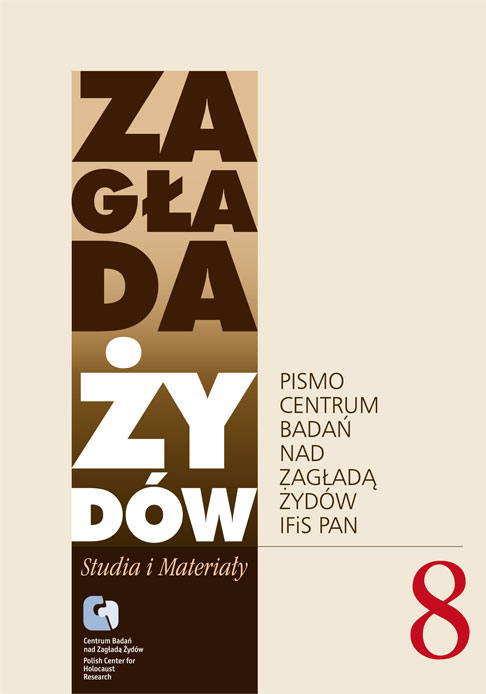Odmienne sylwetki przybyłych do Szwecji więźniów pochodzenia żydowskiego i nieżydowskiego, ocalałych z obozów koncentracyjnych na ziemiach polskich
Zagłada Żydów. Studia i Materiały, Nr 8 (2012), Strony: 419-429
Data zgłoszenia: 2020-12-06Data publikacji: 2012-12-02
 https://doi.org/10.32927/zzsim.698
https://doi.org/10.32927/zzsim.698
Abstrakt
Survivors from Nazi concentration camps, who were brought to Sweden as refugees during the last month of the Second World War and during the summer that followed, were often required to supply information about personal details to the authorities. Much of the information was later stored in written form in the Swedish National Archives. Antisemitism among the refugees and enmity between the Jewish and non-Jewish Polish refugees caused the authorities to include their ethnic or religious affiliation in many records and documents. Using mainly two collections from the Swedish National Archives it is shown that substantial differences existed between Jewish and non-Jewish Polish refugees with respect to their age, education and the length of their war experiences. These differences, in addition to the existing socio-geographic, demographic, cultural and ethnic differences led to inevitable clashes between the two groups. The Swedish authorities who first regarded all refugees of Polish citizenship as one national group had to revise this attitude gradually during the administration of the refugees
Słowa kluczowe
ocalali z Zagłady , Szwecja , stosunki polsko-żydowskie
Licencja
Prawa autorskie (c) 2012 Autor&"Zagłada Żydów. Studia i Materiały"

Utwór dostępny jest na licencji Creative Commons Uznanie autorstwa 4.0 Międzynarodowe.
https://creativecommons.org/licenses/by/4.0
Czasopismo publikowane jest w standardzie Diamond Open Access na licencji CC-BY-4.0 Deed - Uznanie autorstwa 4.0 Międzynarodowa - Creative Commons
Podobne artykuły
- Adriana Bryk, „Najlepsze dziecko Prezesa” – poczta w getcie łódzkim (1939–1944) , Zagłada Żydów. Studia i Materiały: Nr 16 (2020)
- Joanna Tokarska-Bakir, Przedziały śmierci. O książce Jana Grabowskiego, "Na posterunku. Udział polskiej policji granatowej i kryminalnej w zagładzie Żydów" , Zagłada Żydów. Studia i Materiały: Nr 16 (2020)
- Stanisław Obirek, Dariusz Libionka (red.), Obóz zagłady w Bełżcu w relacjach ocalonych i zeznaniach polskich świadków , Zagłada Żydów. Studia i Materiały: Nr 10 (2014)
- Dariusz Libionka, Uwagi o ratowaniu Żydów w „okolicach Treblinki” [recenzja: Edward Kopówka, ks. Paweł Rytel-Andrianik, Dam im imię na wieki. Polacy z okolic Treblinki ratujący Żydów] , Zagłada Żydów. Studia i Materiały: Nr 9 (2013)
- Havi Dreifuss, Matys Gelman – nieznany przywódca nieznanego ruchu chasydzkiego w czasie Zagłady , Zagłada Żydów. Studia i Materiały: Nr 15 (2019)
- Marta Janczewska, Wspomnienia, relacje, dzienniki – seria wydawnicza Żydowskiego Instytutu Historycznego INB , Zagłada Żydów. Studia i Materiały: Nr 3 (2007)
- Jacek Leociak, Miriam Akawia, Haderech ha’acheret , Zagłada Żydów. Studia i Materiały: Nr 3 (2007)
- Ewa Mork, Omówienia najnowszej literatury na temat Zagłady Żydów: Skandynavia , Zagłada Żydów. Studia i Materiały: Nr 3 (2007)
- Jacek Leociak, “History and Memory after the Holocaust in Germany, Poland, Russia, and Britain” , Zagłada Żydów. Studia i Materiały: Nr 3 (2007)
- Paweł Dobrosielski, Opowiadanie Marka Hłaski „Szukając gwiazd” jako parabola Holokaustu i mityczne „wydarzenie początkowe” w twórczości pisarza , Zagłada Żydów. Studia i Materiały: Nr 4 (2008)
<< < 3 4 5 6 7 8 9 10 11 12 13 14 15 16 17 18 19 20 21 22 23 24 25 26 27 28 29 30 31 32 33 34 35 36 37 38 39 40 41 42 43 44 45 46 47 48 49 50 > >>
Możesz również Rozpocznij zaawansowane wyszukiwanie podobieństw dla tego artykułu.
 English
English
 Język Polski
Język Polski




